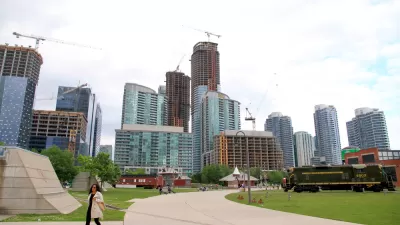The question of how and where to grow is causing controversy in Toronto. A recent op-ed picks a side.

An op-ed by Dave Wilkes, president and CEO of the Building Industry and Land Development Association (BILD), announces support for proposed changes to the controversial Growth Plan under consideration in Toronto.
For Wilkes, the question of whether to support the plan comes down to housing, and the current plan isn't building enough of it.
Much has been written about the proposed changes to the Growth Plan, the policy that manages growth in the Greater Golden Horseshoe. Many commentators have warned that the changes will bring more sprawl. By using that loaded word, they obscure the real issue we should be discussing: How do we build an adequate supply of housing for people in our region in a sustainable way?
Right now, we are not building nearly enough to accommodate the 115,000 people arriving in the GTA every year, and our worsening housing affordability attests to that. With the proposed changes to the Growth Plan, the provincial government is taking action to help increase housing supply while continuing to protect the environment.
According to Wilkes, the areas of the region targeted for growth are too resistant to new development for the plan to be effective. So density isn't being added to the areas with the transportation infrastructure to support it.
Instead, densification is being pushed to outlying areas of municipalities like Brampton, Vaughan and Pickering, on land designated for future development. Often, these areas are not served by transit, so residents have to drive, contributing to the traffic congestion and emissions that the Growth Plan was meant to alleviate.
Wilkes is responding to the position described in a news article by Ben Spurr from January of this year. Ontario Premier Doug Ford ran for office on a campaign platform that included a plan to expand the growth boundary surrounding the region.
FULL STORY: BILD: A lack of housing is the real issue

Alabama: Trump Terminates Settlements for Black Communities Harmed By Raw Sewage
Trump deemed the landmark civil rights agreement “illegal DEI and environmental justice policy.”

Planetizen Federal Action Tracker
A weekly monitor of how Trump’s orders and actions are impacting planners and planning in America.

The 120 Year Old Tiny Home Villages That Sheltered San Francisco’s Earthquake Refugees
More than a century ago, San Francisco mobilized to house thousands of residents displaced by the 1906 earthquake. Could their strategy offer a model for the present?

In Both Crashes and Crime, Public Transportation is Far Safer than Driving
Contrary to popular assumptions, public transportation has far lower crash and crime rates than automobile travel. For safer communities, improve and encourage transit travel.

Report: Zoning Reforms Should Complement Nashville’s Ambitious Transit Plan
Without reform, restrictive zoning codes will limit the impact of the city’s planned transit expansion and could exclude some of the residents who depend on transit the most.

Judge Orders Release of Frozen IRA, IIJA Funding
The decision is a victory for environmental groups who charged that freezing funds for critical infrastructure and disaster response programs caused “real and irreparable harm” to communities.
Urban Design for Planners 1: Software Tools
This six-course series explores essential urban design concepts using open source software and equips planners with the tools they need to participate fully in the urban design process.
Planning for Universal Design
Learn the tools for implementing Universal Design in planning regulations.
Clanton & Associates, Inc.
Jessamine County Fiscal Court
Institute for Housing and Urban Development Studies (IHS)
City of Grandview
Harvard GSD Executive Education
Toledo-Lucas County Plan Commissions
Salt Lake City
NYU Wagner Graduate School of Public Service





























